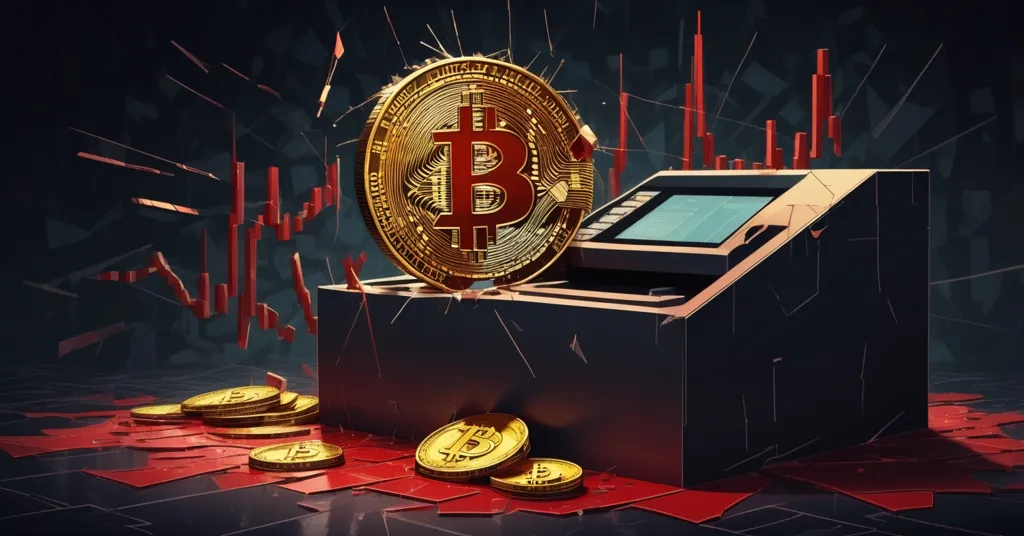Crypto CEO Blasts Bitcoin’s “Digital Gold” Narrative: Is Its True Purpose Lost?

Crypto CEO Slams Bitcoin’s “Digital Gold” Myth: What Was It Really Meant to Be?
Bitcoin’s reputation as “digital gold” has taken a beating in 2025, with its price crashing hard and a crypto CEO throwing punches at the narrative. Jacob King, an outspoken figure in the industry, claims Bitcoin was never meant to be a store of value or a safe haven asset—it was built to be something else entirely. As the market reels, let’s unpack this debate and figure out what Bitcoin truly stands for.
- Market Meltdown: Bitcoin has wiped out most of its 2025 gains, trading at $84,130 amid chaos and liquidations.
- Identity Crisis: Jacob King insists Bitcoin’s purpose as peer-to-peer cash, per Satoshi Nakamoto’s vision, has been hijacked by the “digital gold” hype.
- Heavyweight Pushback: Industry titans like Michael Saylor and Larry Fink double down on Bitcoin as a gold competitor, despite its flaws.
Bitcoin’s Brutal 2025 Reality Check
The crypto market is a bloodbath right now. Bitcoin, once hyped as a bulletproof hedge against inflation and global uncertainty, has plummeted from its 2025 highs to a sobering $84,130. This isn’t just a dip—it’s a full-blown reversal of gains, triggering massive liquidations, tanking investor confidence, and dragging down altcoins with it. Sentiment is in the gutter, and questions about Bitcoin’s reliability are louder than ever. What caused this crash? While specifics remain murky, whispers of a global recession, tightening regulations in key markets, or even a major security breach could be to blame. Regardless, the timing couldn’t be worse for Bitcoin’s image as a stable asset.
Enter Jacob King, a crypto CEO with zero patience for the fairy tales spun around Bitcoin. With the market in freefall, he’s calling out the community for straying from Bitcoin’s roots. His argument isn’t new, but it’s brutal: Bitcoin was never designed to be “digital gold.” It’s a narrative, he says, cooked up to keep the hype alive as Bitcoin’s practical use faltered. For more on his perspective, check out this detailed take on Bitcoin’s true purpose.
Satoshi’s Forgotten Dream: Cash, Not Gold
Let’s rewind to 2008, when a mysterious figure named Satoshi Nakamoto dropped the Bitcoin whitepaper—a blueprint for a revolutionary kind of internet money. For those new to this, the whitepaper was a short document outlining a system where people could send payments directly to each other online, no banks or middlemen required. It was called a “peer-to-peer electronic cash system,” meant to empower individuals with fast, secure, and private transactions. Think of it as digital cash you could use without anyone snooping or skimming fees off the top.
King leans hard on this vision, arguing it’s been buried under years of speculation and marketing spin. He’s not mincing words either.
“Satoshi explicitly described Bitcoin as a peer-to-peer system for online payments. The idea of Bitcoin as a form of digital gold was manufactured by maximalists to attract fresh waves of retail buyers.”
His point is sharp and damning. Somewhere between Satoshi’s manifesto and today’s headlines, Bitcoin got rebranded. As its price skyrocketed over the years, it became less about buying a coffee and more about hoarding a shiny digital asset. But why did this shift happen? The answer lies in Bitcoin’s growing pains—issues that made Satoshi’s dream tough to execute in the real world.
Why Bitcoin Struggles as Everyday Money
Here’s the harsh truth for newcomers and veterans alike: Bitcoin isn’t built for the kind of speed or scale needed for day-to-day payments. The network can only process a handful of transactions per second—compare that to Visa, which handles thousands. This is called “transaction throughput,” or simply, how many payments Bitcoin can churn out at once. It’s painfully slow. On top of that, fees can be outrageous. During peak congestion, like in 2021, average fees spiked to over $50 per transaction. Good luck using that to grab a $5 latte—Bitcoin’s more likely to buy you a yacht than a coffee with those costs.
Imagine a small business owner in 2025 trying to accept Bitcoin for their products. A customer pays, but the transaction takes forever to confirm, and the fee eats into the profit margin. It’s a non-starter. King argues that as these flaws became undeniable, the community pivoted. Instead of admitting Bitcoin wasn’t cutting it as cash, they sold a new story: Bitcoin as a store of value, a modern rival to gold. It was a slick move to keep investors pouring in, even if real-world use as a currency withered.
Digital Gold: Fact or Fiction?
Now, let’s look at the other side—the pitch that’s dominated Bitcoin’s image for years. The “digital gold” storyline isn’t just idle chatter; it’s been championed by some of the biggest names in finance and tech. Michael Saylor, CEO of MicroStrategy and a Bitcoin evangelist, has been relentless in framing it as the ultimate asset.
“Bitcoin is the superior successor to gold, calling it ‘digital property.’”
Larry Fink, the powerhouse behind BlackRock, has echoed this, pointing to Bitcoin’s appeal in turbulent times.
“Bitcoin had become a hedge to overcome and address local fears.”
Tom Lee of Fundstrat Global takes it further with eye-popping predictions, suggesting Bitcoin could soar if it eats into gold’s territory.
“Bitcoin’s valuation could climb to the $200,000 to $250,000 range if it manages to capture 25% of gold’s market share.”
Even Jerome Powell, head of the Federal Reserve, has weighed in, giving Bitcoin a nod as a serious player.
“Bitcoin now acts as a legitimate competitor to gold.”
These aren’t fringe voices—they’re titans shaping how the world sees Bitcoin. Their backing has fueled institutional adoption, with firms like BlackRock pushing Bitcoin into mainstream portfolios. The logic isn’t baseless either. Bitcoin’s hardcoded limit of 21 million coins—meaning no more will ever be created—mirrors gold’s scarcity. Its decentralized setup also offers a shield against government overreach or currency devaluation, a big draw when central banks are printing cash like it’s going out of style. In places like Venezuela, where hyperinflation has gutted savings, Bitcoin has been a lifeline for some to preserve wealth or move money across borders.
But here’s where King’s critique bites. If Bitcoin is digital gold, why is it cratering in 2025 alongside risky assets like stocks? A true safe haven should hold steady—or even rise—when everything else tanks. Instead, Bitcoin’s notorious volatility is on full display, undermining the very label its cheerleaders cling to. The $84,130 price tag today is a far cry from the lofty promises of stability. Are we just slapping a fancy title on a wildly unpredictable gamble?
Playing Devil’s Advocate: Why Digital Gold Might Still Hold
Let’s flip the script for a second. Despite the current bloodshed, there’s a case for Bitcoin as a long-term store of value, especially for the HODLers—those diehards who hold on through every storm. They argue volatility is just noise. Over a decade, Bitcoin’s price has trended upward, outpacing inflation and fiat currencies that lose value over time. Its censorship resistance is another ace up its sleeve. In authoritarian regimes, where bank accounts can be frozen or assets seized, Bitcoin offers a way to store wealth outside the system. That’s not just theory—it’s a reality for activists and dissidents worldwide.
Plus, institutional buy-in isn’t a fluke. When giants like BlackRock and MicroStrategy stack Bitcoin on their balance sheets, it signals confidence that this isn’t a passing fad. Maybe Bitcoin’s role as “digital property” isn’t fully baked yet, but it’s a bet on a future where fiat money keeps eroding. King might scoff, but for longtime believers, the 2025 crash is just another bump on a much longer road.
The Bigger Picture: Bitcoin’s Identity Crisis
Zooming out, this isn’t just a spat over semantics—it’s an existential reckoning for Bitcoin. The tension between Satoshi’s vision of decentralized cash and today’s speculative asset mirrors a broader rift in the crypto world. Purists pine for a return to peer-to-peer payments, free from banks and borders. Meanwhile, pragmatists—and big money—see Bitcoin settling into a niche as a reserve asset, while other blockchains pick up the slack on usability.
Speaking of other players, altcoins and protocols like Ethereum, Solana, and even Bitcoin’s own Lightning Network are tackling use cases Bitcoin can’t touch right now. Ethereum’s Layer 2 solutions, for instance, slash fees and speed up transactions, making it a contender for everyday payments. Stablecoins, pegged to real-world currencies, offer price stability Bitcoin lacks. Perhaps Bitcoin doesn’t need to be all things to all people. Maybe it’s fine as a digital vault while others handle the cashier duties. Or maybe, as King warns, we’ve drifted so far from the original plan that we’ve lost what made Bitcoin revolutionary in the first place.
The community’s reaction to King’s comments adds another layer. On platforms like X, Bitcoin maximalists are split—some blast him as a heretic undermining the cause, while others begrudgingly nod, admitting the currency dream feels dead. This fracture shows how high the stakes are. Bitcoin’s purpose isn’t just a debate; it’s the soul of the movement.
What’s Next for Bitcoin?
As the dust settles from this year’s price massacre, Bitcoin’s path forward is anything but clear. Could tech like the Lightning Network—a secondary layer built on Bitcoin to speed up transactions and cut fees—revive its use as cash? Will institutional adoption, despite the crash, cement the digital gold label for good? Or are we stuck in limbo, with Bitcoin as neither a usable currency nor a reliable asset, just a speculative toy for the brave and reckless?
The beauty—and frustration—of this space is that we’re forging the future of money on the fly. Every crash, every hot take, every clash of ideals is a piece of the puzzle. Bitcoin’s story isn’t over, not by a long shot. Whether it reclaims Satoshi’s vision, doubles down as a gold rival, or carves out some hybrid role, the fight over its soul is what keeps us hooked. Let’s break down some key questions to frame where things stand.
- What was Bitcoin originally built for?
Satoshi Nakamoto’s 2008 whitepaper defined it as a peer-to-peer electronic cash system for direct online payments, cutting out banks and intermediaries. - Why is Bitcoin called digital gold?
Influencers like Michael Saylor and Larry Fink have pitched it as a store of value and inflation hedge, drawing parallels to gold’s scarcity to lure investors. - Does the 2025 Bitcoin price crash hurt its safe-haven image?
Without a doubt—slumping to $84,130 during economic turmoil suggests Bitcoin isn’t the unshakable refuge some claim, backing King’s doubts. - Can Bitcoin still function as a currency with its flaws?
Barely; sky-high fees and slow transaction speeds make it impractical for daily use, a core reason King says the original mission has been abandoned. - Are big-name endorsements overshadowing Bitcoin’s roots?
Largely, yes—voices like Jerome Powell and Tom Lee focus on Bitcoin as an investment, often drowning out its initial goal as decentralized money. - Could other blockchains fill Bitcoin’s gaps?
Quite possibly; Ethereum’s upgrades, Solana’s speed, and stablecoins’ stability address payment needs Bitcoin struggles with, suggesting a divided future for crypto roles.
The showdown between Bitcoin’s past and present is raw and unresolved. Jacob King’s gut-punch critique forces us to ask hard questions: Are we honoring the radical idea that started it all, or just chasing the next bull run with shiny buzzwords? As the market staggers through 2025, Bitcoin’s real challenge isn’t just clawing back to its highs—it’s proving it has a purpose worth believing in. In this wild west of finance, nothing’s set in stone, and every idea’s fair game. That’s the chaos—and the thrill—of it all.



